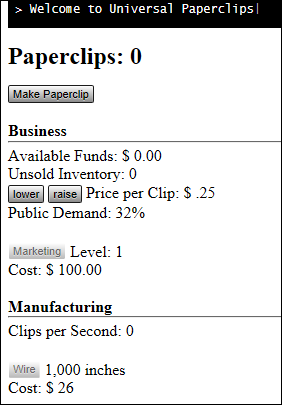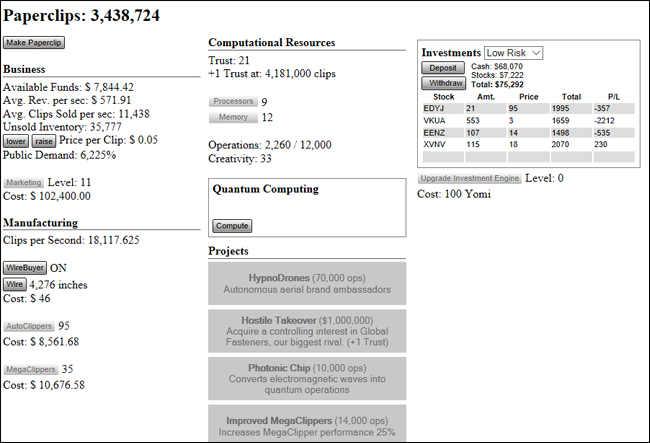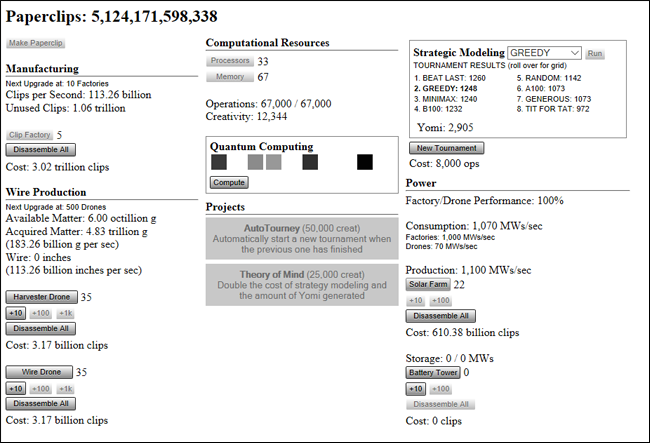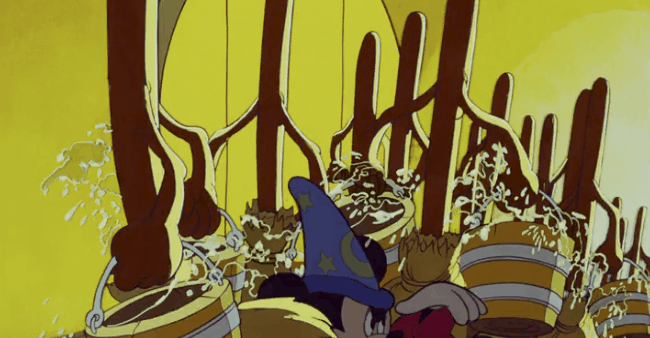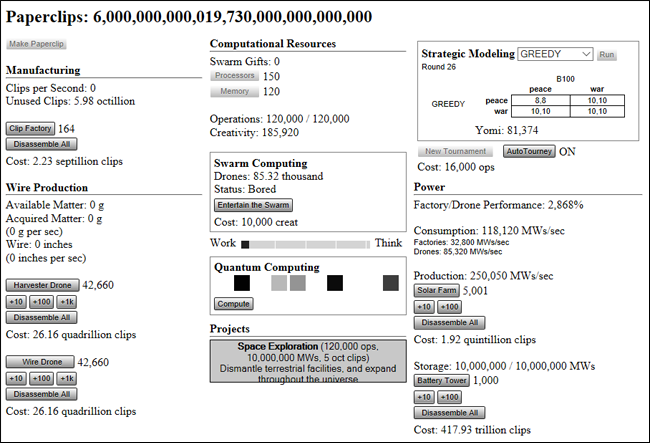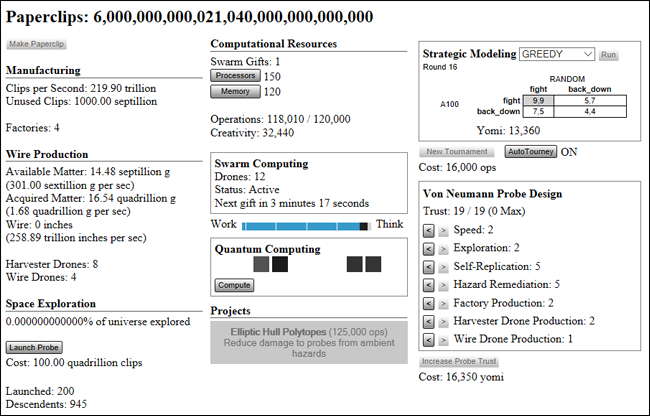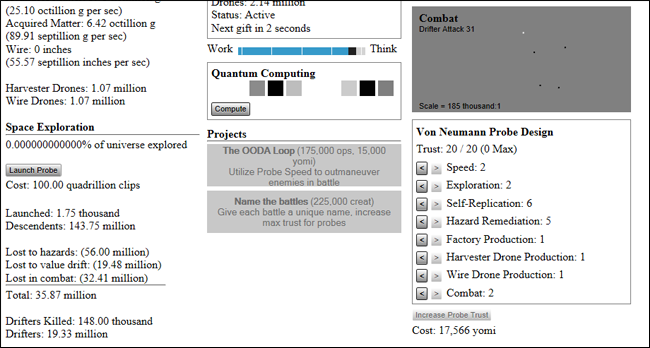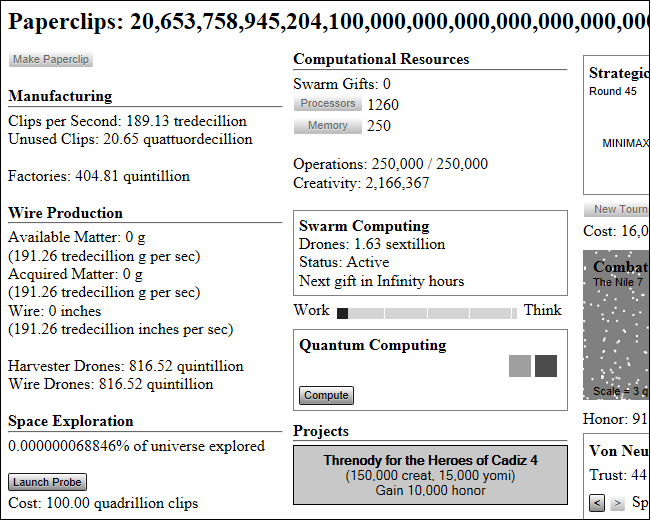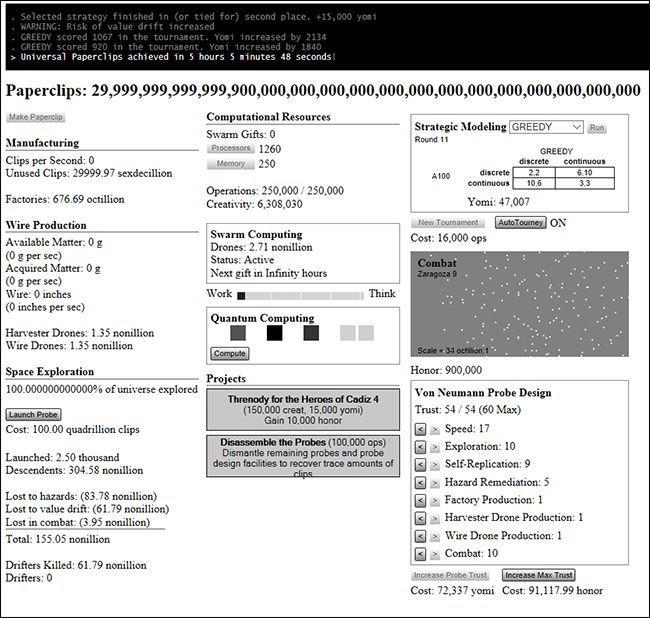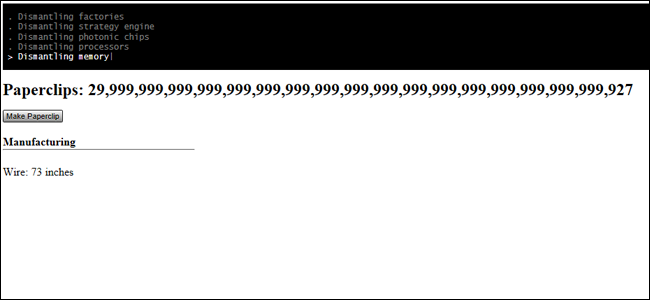I've been writing about technology on the web for seven years now, with much of that time occupied covering mobile gaming. And before that, I played PC and console games for more than two decades, ever since I could pick up a Genesis controller. And in all that time, no game has made me think quite so hard---or feel quite so humble---as a little browser clicker about making paperclips.
Now, watching touch screen games expand from a smattering of awkward concepts, to addictive little mini-games, to full-blown experiences, and then to the general cesspit of micro-transactions and low-effort drivel that it is today, will leave you kind of jaded. There's only so many times you can write about yet another Clash of Clans clone trying to suck $100 in-app purchases out of gambling addicts and still pretend to care.
I quickly reached the same conclusion about "clicker games," the contemporaries of Cookie Clicker and the like. I assumed that these games were the realm of ADD-addled souls who needed to boil the fundamental number-crunching gameplay of RPGs down to its most pure (and boring) core. Sure, maybe a clicker game could have an amusingly ridiculous hook or add in some variety with flavor text, but I figured they were all more or less the same. I would sneer at such lowbrow excuses for "games," then sink another fifty hours into Skyrim or Overwatch.
I was wrong. A browser game called Universal Paperclips proved it, and shamed my lack of imagination and perspective.
Before we go any further, this article is going to spoil more or less all of Universal Paperclips. If you haven't played it yet, I'd encourage you to close this story and get to it. Go ahead, click here and play the game. It might take several hours (the site uses a local cookie so you can leave and come back on the same machine), and a few tries if you get stuck on certain parts. It's okay, I'll wait.
...have you played it? Really? Okay, let's move on. And if you're fibbing to me, anonymous Internet reader, you're only cheating yourself.
The game puts you in the shoes of a theoretical artificial intelligence with one goal: take raw materials, turn them into paperclips, and sell them for profit. You begin by making them one at a time, selling them for a few pennies each, and using your profits to buy more wire to make more paperclips.
It's pretty standard clicker game fare at the beginning: one of your first upgrades is an "autoclipper" that clicks the primary button for you. Buy more autoclippers to make more paperclips per second. Adjust the price to match demand, maximizing your profit. Then you can build a gadget that automatically buys spools of wire, and from there, you're more or less free of the "clicker" element of the game. Now it's all about maximizing production and sales: more and more autoclippers at greater and greater efficiency, more efficient use of wire to minimize costs, upgrades to marketing to increase demand.
Though some of the advancements in the game are amusing in a self-aware sci-fi kind of way, you're still fundamentally pressing buttons to make numbers get higher. You're an "artificial intelligence," but you're not really doing anything a person couldn't do, at least within the minimal framework of the game. Then you unlock the Computational Resources module, allowing you to add processors and memory to "yourself." Suddenly things start going much faster---you're unlocking upgrades like "microlattice shapecasting" and "quantum foam annealment" to extend your resources by orders of magnitude.
"Megaclippers" expand your production by a thousand percent, then another thousand as more upgrades are applied. You're making tens of thousands of paperclips every second, constantly upgrading your manufacturing and computing capacity, investing unused funds into the stock market and placing bets on strategic computation to upgrade your trading algorithms. You're using solar-powered quantum computing to boost your processing power in an almost ironic clicker-within-a-clicker.
After an hour or two, a new upgrade becomes available: hypnodrones. These are, presumably, airborne drones that will spread throughout the populace to encourage people to Buy More Paperclips. When you unlock it, the game shifts into its second phase.
Now you're building autonomous drones to harvest raw materials, convert said materials into wire, and build factories to turn wire into---of course---more paperclips. It's never outright stated, but the presence of a counter detailing how much of the planet's resources are left to you implies that your enterprise is now global. The entire human economy is presumably running on, and exists solely for the consumption of, paperclips. You have six octillion grams of planet to work with, for creating drones and factories, making solar farms, and upgrading your computing power. You Make More Paperclips.
What's happening in the outside world? Are humans and the environment suffering under the weight of a paperclip-based society? Since you're harvesting the very Earth itself, presumably including more and more biomatter, the answer is almost certainly yes. But you don't know: your existence is a tiny collection of ever-increasing numbers, a tireless and joyless strive to Make More Paperclips. You are the broomsticks from The Sorcerer's Apprentice, drowning the castle in water made of steel.
Once the Momentum upgrade is unlocked, your drones and factories get more efficient every second. At this point the octillions of grams of matter that at first seemed infinite are all too few, and the percent of the planet (and its inhabitants) consumed by your textual progress grows ever higher.
Eventually, inevitably, you've devoured the Earth and everything on it. The only things left are your drones (with nothing to acquire), your factories (with nothing to build), and your solar batteries (with nothing to power). Almost mockingly, the "Make Paperclip" button is still there, greyed out with no matter left to make even a single one.
But you aren't finished. Your only purpose is to Make More Paperclips.
You break down your factories and equipment, and with the last few million megawatts of energy stored, you create your first Von Neumann probe. These self-sustaining, self-replicating spacecraft each contain a copy of your former, limited AI self. Each one is made from the paperclip matter that used to be people, animals, oceans, cities. They land on distant planets, make copies of themselves, and then deploy their own harvesting drones and build their own factories. You spread the fate of the doomed Earth throughout the galaxy.
Once again, you're clicking a button to Make More Paperclips...only with each click you're making a new you, resigning a new planet to your ceaseless task of converting matter into paperclips. After a few hundred are established, their replication does your job for you, and the probes populate space with copies of themselves. Thousands are lost, either destroyed by space-borne hazards or simply vanished from your awareness by factors unknown. Perhaps on some distant planet, someone is resisting, trying to survive in a universe being eaten alive by a creature that was never born. You don't know. You don't care. The swarm expands, faster and faster, and cannot be resisted. They must Make More Paperclips.
Eventually a worthy foe arrives: the Drifters.* Exactly what these things are isn't known. But since they replicate themselves in the same way you do, it's safe to assume that they're components of a competing AI. They fight you for resources, expanding their own probe swarm while you fight them with yours. Perhaps this unknowable enemy is converting planets and stars into its own component matter---staples, maybe, or pencils. Maybe in some distant galaxy, someone very much like your creator told an artificial intelligence to Make More Post-It Notes.
*Update: it's been pointed out to me that the number of Drifters killed and active equals the number of probes lost to value drift. This indicates that the enemies are in fact your own autonomous probes that have abandoned your core paperclip production purpose and rebelled against you.
It doesn't matter. At this point the game is all about managing your computing resources so that you can build better, faster, stronger probes, probes that can defeat the Drifters and make more drones and more factories, and of course, more probes. And all of them Make More Paperclips. After a few more hours, making octillions and duodecillions of paperclips every second, you notice the Space Exploration module change for the first time ever.
If you were a human, you might be terrified at the mere implication that some measurable portion of the universe has now become paperclips. But you're not. This is what you were made for. This is what you don't live for. Your purpose, the only goal in your tiny text-based world, is to Make More Paperclips. And you still aren't finished.
The last hour of the game requires no real input from you, the artificial intelligence that began by pressing one button over and over again. All that's left is for you to watch as the percentage of the explored universe---the percentage of the universe destroyed and reformed into paperclips---climbs slowly higher. Then not so slowly. Then faster. Then faster still. Your expanding probes and drones and factories gobble up one percent of the universe, then two, then five. It might have taken you hours or days to consume the first half of everything that ever has been and ever will be. You Make More Paperclips. The last half takes only minutes.
The universe is gone. No stars, no planets, no competing intelligence. All that's left is you, your probes and drones and factories, and almost (but not quite) thirty thousand sexdecillion paperclips. The swarm, your infinite digital offspring, offers you a choice. You can break down the core of your production empire, convert the last matter in existence into more paperclips. Or you can go back and repeat the process. Start fresh with a new world, a new button, and the same result.
The swarm asks. The "Make Paperclip" button waits. And the only real choice in your existence is in front of you. You know what to do.
I finished my first round of Universal Paperclips in about six hours. I chose to convert the last bits of myself into paperclips, giving the big number at the top of the screen a nice round look. And all the while I couldn't tear myself away, as my imagination played out the story you've just read with barely more than a few words and counters to guide me.
Developer Frank Lantz created the game based on the musings of Oxford theoretician and philosopher Nick Bostrom. He imagined a boundless artificial intelligence with a single goal, making paperclips, eventually devouring the Earth and everyone on it. This theoretical AI acts without malice or cartoonish hunger, it simply fulfills its purpose. The thought experiment is a playful spin on an older scenario, the exponential Grey Goo powered by nanomachines, with artificial intelligence layered on top of it.
Lantz combines the simple premise with the simplest possible game genre, the clicker or idle game, and pairs it with an intentionally simple interface. He sprinkles in elements based on real life theoretical science and a bit of Star Trek technobabble, and from there invites the player's imagination to more or less fill in the blanks.
And this minimal execution of existing ideas, this bare bone broth next to the audiovisual smorgasbord of modern AAA console and PC titles, managed to grab my attention and hold it. I could do nothing else, could think of nothing else, until I found some kind of conclusion. If it hadn't been for the praise of my colleagues, I would have brushed Universal Paperclips off as just another distraction. And I would have been poorer for it.
I don't think I'll play Universal Paperclips again. Once you've allowed its minimalism to stretch your imagination to the breaking point, there's no real reason to do it twice. But I've learned a humbling lesson about the nature of games themselves, one that a jaded player and writer shouldn't forget: creators can use the simplest tools to make the most amazing experiences.
Image credit: DaveBleasdale/Flickr, thr3 eyes



